Biliary Atresia - Know More About It!
Biliary Atresia is a rare gastrointestinal disorder which affects one in about twenty thousand infants due to scarred or blocked or damaged bile duct. This condition prevents the flow of bile juice from the gall bladder into the intestine, leading to its accumulation. Thus, as a result, the liver might be scarred leading to a decreased function or totally damaged, requiring a transplant. Bile juice is required for emulsification of fat to break its complex component into simpler components for digestion.
Causes-
Biliary Atresia is believed to be congenital (present at the time of birth itself). It is neither hereditary nor contagious or preventable. It is often linked with viral infection early in life.
Symptoms-
The infants born with Biliary Atresia first appear to be healthy. However, over a period of time, their symptoms manifest. There are several symptoms associated with Biliary Atresia, as discussed below:
● Jaundice is typically the major symptom for Biliary Atresia.
● A swollen abdomen due to an enlarged liver.
● Dark colored urine is caused by the accumulation of bilirubin.
● Acholic or clay-colored stool is caused due to the accumulation of bile and bilirubin.
● As the intensity or severity of jaundice increases, it leads to irritability, itching, malnutrition, and weight loss in infants.
Diagnosis-
Since, Jaundice is a common symptom for liver disorders, suffering from jaundice alone is insufficient to ascertain the case of Biliary Atresia. For diagnosing this condition, some of the following tests might be recommended by the doctor:
● Blood tests to analyze liver function;
● X-Ray to check the enlarged liver and spleen;
● Liver biopsy;
● Diagnostic surgery to look for damaged bile duct from liver to the intestine;
● An operative cholangiogram (a specialized X-Ray) during surgery.
Treatment-
Biliary Atresia cannot be treated with medication. It is generally treated with the Kasai procedure at first, and then a liver transplant. The Kasai procedure, also called Hepatoportoenterostomy, is a corrective surgical procedure for re-establishing the flow of bile juice from the liver to the intestine. The blocked or damaged ducts are removed and the healthy ones are connected directly to
the intestine for draining off the bile juice. Post the Kasai procedure, antibiotics are recommended to prevent the chances of infection. Also, additional medications might then be prescribed to maximize the success of the procedure. For about 85% of the cases, this procedure is successful. When the Kasai procedure fails for around 15% of the cases of Biliary Atresia, liver
transplantation is performed.
Take Away-
Biliary Atresia is a rare gastrointestinal disorder. It prevents the flow of bile juice from the gall bladder into the intestine, leading to its accumulation, ultimately leading to scarring or failure of the liver. Jaundice is an important symptom. Biliary Atresia cannot be treated with medication. The Kasai procedure and a liver transplant are the procedures performed to correct the condition.



+1.svg)
